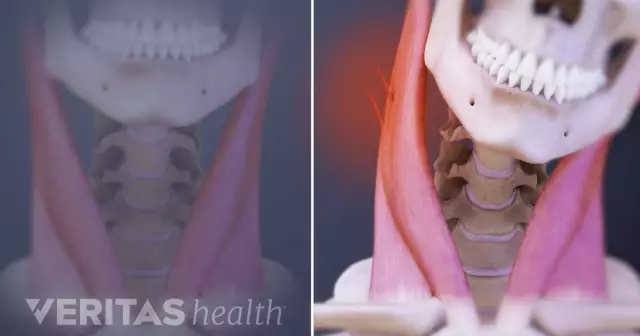- Author Rachel Wainwright [email protected].
- Public 2024-01-15 19:51.
- Last modified 2025-11-02 20:14.
Hypotrophy
The content of the article:
- Causes and risk factors
- Kinds
- Degrees of hypotrophy
- Signs
- Diagnostics
- Treatment
- Potential consequences and complications
- Forecast
- Prevention
Hypotrophy (protein-energy malnutrition) is a clinical syndrome that occurs in children against the background of severe diseases or due to nutritional deficiency (imbalance in nutrient intake, underfeeding). It is characterized by a reduced body weight in relation to the age norm, as well as a violation of tissue trophism, and, as a consequence, a violation of the development and functioning of internal organs.
Hypotrophy is a common pathology in childhood. According to medical statistics, in 5% of cases of visits to a pediatrician are associated with insufficient weight gain.

Source: serebryanskaya.com
Causes and risk factors
Hypotrophy can develop under the influence of a number of exogenous (external) and endogenous (internal) causes. Exogenous include:
- alimentary (nutrition that does not correspond to age, underfeeding);
- infectious (acute infectious diseases, sepsis);
- social (low social level of the family, defect in upbringing).
The following diseases and pathological conditions become internal causes of hypotrophy:
- anomalies of the constitution (diathesis);
- malformations of internal organs;
- neuroendocrine and endocrine disorders (pituitary dwarfism, adrenogenital syndrome, hypothyroidism, thymus abnormalities);
- violation of the absorption process in the intestine (malabsorption syndrome, lactose deficiency, celiac disease);
- insufficient breakdown of nutrients (cystic fibrosis);
- primary metabolic disorders (fat, protein, carbohydrate);
- some chromosomal diseases.
Factors that increase the risk of developing malnutrition in children are:
- frequent respiratory viral infections;
- intestinal infections;
- pneumonia;
- tuberculosis;
- poor childcare (insufficient sleep, infrequent bathing, lack of walks).
Kinds
Depending on the time of occurrence, the following types of hypotrophy are distinguished:
- congenital (prenatal) - also called fetal malnutrition. Its occurrence is caused by a violation of the uteroplacental circulation, leading to intrauterine growth retardation. Prenatal hypotrophy is always combined with fetal hypoxia;
- acquired (postnatal) - the basis of its development is a protein-energy deficit resulting from insufficient intake of nutrients and energy into the child's body (i.e., the intake of nutrients in an amount that does not cover the costs of the body);
- mixed - caused by a combination of pre- and postnatal factors.
Prenatal malnutrition, depending on the clinical manifestations, is divided into the following types:
- neuropathic - weight loss is insignificant, sleep and appetite disturbances are noted;
- neurodystrophic - characterized by a decrease in body weight, a lag in psychomotor development, persistent anorexia;
- neuroendocrine - characterized by a violation of the endocrine regulation of psychomotor development, as well as the functional state of internal organs;
- encephalopathic - manifested by a pronounced neurological deficit, a severe lag in the child's mental and physical development, hypoplasia of the skeletal system.
Degrees of hypotrophy
Depending on the body weight deficit, the following degrees of malnutrition in children are distinguished:
- Lightweight. The deficit is 10-20%, body length corresponds to the age norm.
- Average. The body weight is reduced by 20-30%, there is a growth retardation of 2-3 cm.
- Heavy. The deficit exceeds 30%, the child is significantly behind in growth.

Source: present5.com
Signs
Clinical signs of malnutrition in children are determined by the lack of body weight.
With I degree of malnutrition, the general condition of the child remains satisfactory. There is a slight decrease in the thickness of the layer of subcutaneous adipose tissue.
Signs of grade II malnutrition are:
- lability of the central nervous system (decreased emotional tone, lethargy, apathy, agitation);
- dryness, pallor, peeling of the skin;
- reduction of soft tissue turgor and skin elasticity;
- loss of subcutaneous tissue (persists only on the face);
- microcirculation disorders (cold extremities, marbling of the skin);
- dyspeptic disorders (constipation, vomiting, nausea);
- rapid breathing (tachypnea);
- tendency to tachycardia;
- arterial hypotension;
- muffled heart tones.
With III degree of malnutrition, a pronounced developmental delay is observed. The general condition of the child is difficult. There is a loss of previously acquired skills, signs of anorexia, weakness, lethargy are expressed. The skin is pale and dry, with a grayish tinge, gathering in folds (the so-called senile skin). The subcutaneous tissue is completely absent, the face becomes sunken, since Bish's lumps, giving roundness to the children's cheeks, disappear. Muscle wasting develops up to their complete atrophy. The child is like a skeleton covered with skin. Symptoms of dehydration are often present:
- dry mucous membranes;
- retraction of the large fontanelle;
- shallow breathing;
- muffling heart tones;
- significant decrease in blood pressure;
- violation of thermoregulation.
Diagnostics
Diagnosis of malnutrition begins with examination and careful collection of obstetric and postnatal history (especially during pregnancy, maternal illness, toxicosis, course of childbirth, use of obstetric benefits, duration of anhydrous interval, monthly weight gain of the child, past diseases). They also find out the social (socio-economic situation of the family, living conditions) and hereditary (endocrine, metabolic diseases, enzymopathies in family members) anamnesis.
Laboratory diagnostics of malnutrition in children includes the following types of tests:
- complete blood count (hypochromic anemia, increased hematocrit and ESR, thrombocytopenia, leukopenia);
- general and biochemical analysis of urine;
- blood chemistry;
- determination of the acid-base composition of blood;
- determination of the concentration in serum of electrolytes (sodium, calcium, potassium);
- immunogram (performed for infectious processes);
- feces for dysbiosis;
- coprogram;
- endocrine profile (hormones of the adrenal glands, thyroid gland) - if indicated;
- sweat test for chloride content (if cystic fibrosis is suspected);
- virological and bacteriological studies - if infectious processes are suspected.
If necessary, the child is referred for a consultation with an endocrinologist, ophthalmologist, gastroenterologist, etc.
To exclude a specific pulmonary process (tuberculosis, cystic fibrosis), an X-ray examination of the chest organs is performed.
Treatment
At I and II degrees of malnutrition with satisfactory tolerance to food loads, treatment is carried out on an outpatient basis. The indications for hospitalization are:
- age less than one year;
- the presence of infectious or somatic concomitant diseases;
- low tolerance to food stress;
- III degree of malnutrition.
In the treatment of hypotrophy, a properly organized medical nutrition is of fundamental importance. It has three phases:
- Preparatory.
- Enhanced nutrition.
- Restorative.
The purpose of the preparatory phase is to determine the child's tolerance to the food load and its increase, to correct violations of the water-salt balance. With hypotrophy of the I degree, food loads are reduced compared to the norm to 2/3 of the required volume of food, and with II and III degrees of malnutrition to 1 / 3-1 / 2. When breastfeeding a child with hypotrophy of I and II degrees, 100 ml of breast milk is prescribed for each kilogram of body weight per day.
With poor tolerance to food loads, there is a need for parenteral nutrition. For this purpose, solutions of colloids and crystalloids are injected intravenously in a ratio of 1: 1.
The goals of the enhanced feeding phase are to restore all types of metabolism and energy, as well as a transition to complete intestinal nutrition. The calorie content of the diet is 150-180 kcal for each kilogram of the child's actual body weight. The diet is gradually expanded by introducing into it all macro- and micronutrients in age proportions.
General principles of diet therapy for malnutrition:
| Degrees of hypotrophy | |||
| I | II | III | |
| Duration of the period of clarification of food tolerance | 1-3 days | 6-7 days | 10-14 days |
| Type of food | Human milk or adapted lactic acid mixtures | ||
| Daily volume | Full | 2/3 or 1/2 of due | 1/2 or 1/3 of due |
| Number of feedings | 6-7 in 3 hours | 8 after 2.5 hours | 10 in 2 hours |
| Allowable daily food supplements | Full volume without additives | 100-150 ml daily | 100-150 ml every 2 days |
| Criteria for changing the number of feedings | Do not change | When 2/3 of the volume is reached, they switch to 7 feedings after 3 hours | When 1/2 of the volume is reached, they switch to 8 feedings every 2.5 hours, and 2/3 of the volume - 7 feedings every 3 hours |
The restorative phase of therapeutic nutrition is aimed at organizing the normal intake of nutrients in terms of the body weight that should be appropriate for the child's age.
According to indications, the following means are included in the drug treatment regimen for malnutrition:
- enzymes (Festal, Panzinorm forte, Pancreatin) - help to improve digestion;
- Apilak - improves appetite and stimulates anabolic processes;
- anabolic steroids (Nerabolil, Retabolil) - activate protein and mineral metabolism;
- preparations for parenteral nutrition (glucose solutions, saline solutions, fat emulsions, amino acid hydrolysates);
- eubiotics (Bifidumbacterin, Lactobacterin, Bifikol, Colibacterin) - to normalize the intestinal microflora;
- sedatives and drugs that improve metabolic processes in brain tissues (indicated for prenatal dystrophy);
- hormonal drugs (insulin, thyroidin) - in order to normalize metabolism.
In addition, drug therapy is carried out for concomitant somatic and infectious diseases.
Also shown are ultraviolet radiation, massage, physiotherapy exercises, walks in the fresh air.
Potential consequences and complications
The following factors complicate the course of malnutrition:
- lack of proper child care in asocial families;
- infectious complications;
- concomitant pathology.
Against the background of hypotrophy of I and II degrees, children often develop intercurrent diseases (pyelonephritis, pneumonia, otitis media).
With III degree of malnutrition, complications occur with a high frequency. These include:
- Iron-deficiency anemia;
- rickets;
- congestive pneumonia;
- atelectasis in the lungs;
- alopecia (baldness);
- glossitis;
- candidal stomatitis;
- hypoglycemia;
- hypothermia.
Forecast
With timely and complex treatment of hypotrophy of I and II degrees, the prognosis is favorable. With III degree malnutrition, the prognosis is serious. The disease ends in death in 30-50% of cases.
In the case of prenatal malnutrition (fetal malnutrition), the prognosis depends on the degree of hypoxic damage to the central nervous system.
Prevention
Prevention of the development of malnutrition in children includes the following measures:
- rational feeding and balanced nutrition, corresponding to age-related needs;
- organization of the correct daily routine;
- careful child care;
- control of weight gain;
- physical education and hardening;
- timely registration of obstetric records, if necessary - correction of pregnancy pathology;
- proper nutrition and adherence to the daily regimen of the pregnant woman.
YouTube video related to the article:

Elena Minkina Doctor anesthesiologist-resuscitator About the author
Education: graduated from the Tashkent State Medical Institute, specializing in general medicine in 1991. Repeatedly passed refresher courses.
Work experience: anesthesiologist-resuscitator of the city maternity complex, resuscitator of the hemodialysis department.
The information is generalized and provided for informational purposes only. At the first sign of illness, see your doctor. Self-medication is hazardous to health!






